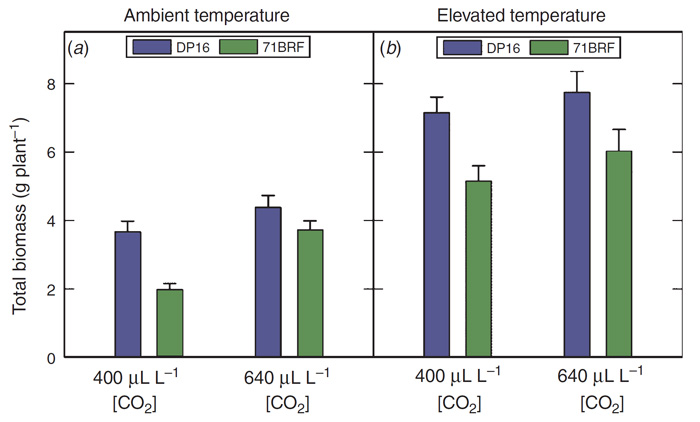| Tweet | Follow @co2science |
Paper Reviewed
Broughton, K.J., Bange, M.P., Duursma, R.A., Payton, P., Smith, R.A., Tan, D.K.Y. and Tissue, D.T. 2017. The effect of elevated atmospheric [CO2] and increased temperatures on an older and modern cotton cultivar. Functional Plant Biology 44: 1207-1218.
Writing as background for their work, Broughton et al. (2017) state that "understanding the implications of integrated environmental impacts on cotton is critical for developing cotton systems that are resilient to stresses induced by climate change." Therefore, it was the objective of their study "to quantify the physiological and growth capacity of two cotton cultivars under current and future climate regimes."
To accomplish their design, the team of seven scientists grew an older cultivar released in the 1970s (Deltapine 16) and a newer transgenic cultivar (Sicot 71BRF) released in 2008 under two temperature (28/17°C or 32/21°C mid-day/night conditions) and two CO2 (400 or 640 ppm) regimes, in a controlled environment glasshouse at the Hawkesbury Institute for the Environment at Western Sydney University in Richmond, NSW, Australia. Seeds were sown in 8-liter pots within each glasshouse and kept watered to field-capacity daily until harvest at 38 days after planting.
In discussing their findings, Broughton et al. report that elevated CO2 increased net photosynthesis and the number of nodes and leaves in both cultivars. It also enhanced their leaf, stem, root and total biomass. With respect to this latter parameter, elevated CO2 increased total biomass under ambient temperatures (28/17°C mid-day/night) by 20 and 90 percent and under elevated temperatures (32/21°C mid-day/night) by 9 and 18 percent in the Deltapine and Sicot cultivars, respectively (see figure below). What is more, the biomass of both cultivars also improved under elevated temperatures, rising 94 and 162 percent in Deltapine and 162 and 208 percent in Sicot plants under 400 and 640 ppm CO2 conditions, respectively. Consequently, the greatest biomass in both cultivars occurred in plants reared in the elevated CO2 and elevated temperature treatment, which plants experienced a whopping 112 (Deltapine) and 208 (Sicot) percent increase in total biomass over their counterparts growing under ambient CO2 and ambient temperatures.
Commenting on their findings, Broughton et al. write that they "provide the platform for genetic screening trials to elucidate the mechanisms that underlie genotypic differences in productivity under elevated [CO2] and temperature," as "genotypic variation in different cotton cultivars may provide opportunities for maximizing yields in warmer, future environments." Indeed, such differences should be examined and incorporated into breeding programs so that scientists can maximize the yield benefits of both temperature and elevated CO2 on cotton and all other crop species!

Figure 1. Effect of growth temperature and atmospheric CO2 content on the total dry biomass production of two cotton cultivars, Deltapine 16 (DP16) and Sicot 71BRF (71BRF), 38 days after planting. Source: Broughton et al. (2017).




